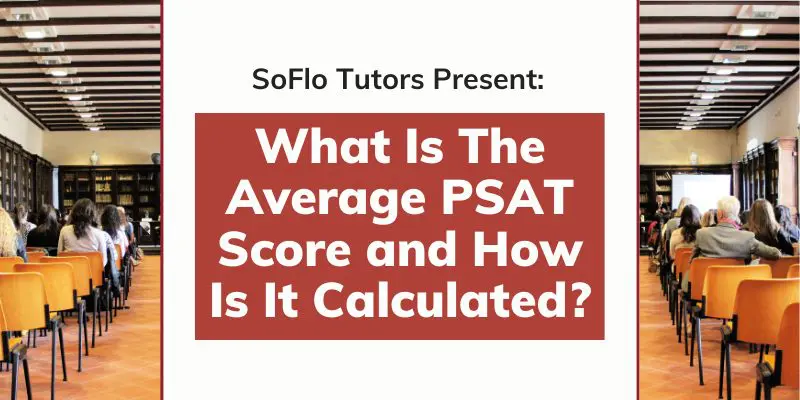
Everything You Need To Know About Average PSAT Scores
You’ve recently taken the PSAT, but how do you know if you got a good score? Your total PSAT score will fall between the range of 320 to 1520, and you can interpret how well your score stacks up when you compare it to the average PSAT score. This is the score that the everyday student is expected to score, and whether your score falls below, above, or right around this benchmark can inform whether or not you received a “good” PSAT score. Read on to find out what is the average PSAT score overall, as well as average scores for each section and by class grade.
What Is An Average PSAT Score
Since all test takers will receive a score between 320 and 1520, it makes sense that the average PSAT score will fall around halfway at 920.
If you want a more mathematical explanation, think back to statistics and remember the bell curve graph. Each test-taker makes up a point on the curve, and the x-axis measures their score from worst to best. The higher the line on the y-axis, the more students received the same score. It makes sense that most students will score towards the middle of the curve while few will score at the extremes. That is how the bell curve shape is created.
You can also think of the average in terms of percentiles. Percentiles allows you to make comparisons between your score and how well the rest of the students taking the same test did. Your percentile rank is the percentage of test takers that you performed better than. For example, if you scored in the 85th percentile, you did better than 85% of total test takers. Check out this article for a more detailed explanation of percentiles with examples.
Therefore, it is easy to pinpoint the average score as it will be the score at the 50th percentile. The average student will have done better (and worse) than 50% of total test takers. This will usually also fall around 920, though it can differ slightly from year to year and also depends on the grade of test takers. For example, in 2021, the 50th percentile PSAT score for 11th graders was 1000.
Average PSAT Score For Each Section
Average PSAT scores can also be calculated for each section of the PSAT: Evidence-Based Reading and Writing and Math. They can be found using the same process as finding the average of the total PSAT score, and the averages around the exact halfway point of the score range. Since the score range of each section is 160 to 760, the averages of each section are expected to hover around 460.
The average Evidence-Based Reading and Writing score for 11th graders usually lies around 510 or 520. The average Math score for 11th graders usually lies around 490. These are the scores at the 50th percentile for each section of the 2021 PSAT.
What Is An Average PSAT Score For Different Grades
As mentioned earlier in the article, the average PSAT score will differ between grades. This is because older students are likely more prepared to take the PSAT and have a greater base of knowledge to draw from. Therefore, the averages of older grades are almost always higher than those of lower grades. Students can take the PSAT beginning in 8th grade and can take it for the final time when they are in 11th grade.
For 8/9th Graders
Some students decide to take the PSAT in their freshman year of high school or even when they are in 8th grade. These test takers are eager to prepare for their junior-year PSAT and often use this test score to begin preparations early. The PSAT given to 8th and 9th graders differs slightly from the PSAT/NMSQT, which is given to 11th grade students. It is called the PSAT 8/9 and has a different yet comparable score range. Rather than the PSAT/NMSQT score range of 320 to 1520, the PSAT 8/9 has a score range lowered by 80 points because it is a slightly easier test. The PSAT 8/9 total score range is 240 to 1440, or 120 to 720 for each section (Evidence-Based Reading and Writing and Math).
Despite the score range difference, calculating average scores remain the same using percentiles. Below is the percentile chart of scores a student would need to receive on the PSAT 8/9 to reach a certain percentile based on 2020 PSAT data.
The average PSAT 8/9 score, or the 50th percentile score, is 850. The average section scores are 430 for Evidence-Based Reading and Writing and 420 for Math.
| PSAT 8/9 percentile | EBRW Score | Math Score | Total Score |
| 99% | 680+ | 680+ | 1350+ |
| 90% | 570 | 550 | 1110 |
| 75% | 500 | 490 | 990 |
| 50% | 420 | 420 | 850 |
For 10th Graders
Sophomores will take the regular PSAT that has a score range of 320 to 1520. Based on 2021 PSAT data, the average PSAT score for a 10th grader, or the 50th percentile score, is 910. The average section scores are 460-470 for Evidence-Based Reading and Writing and 450-460 for Math. Below is a percentile to score chart for high school sophomores taking the PSAT.
| PSAT percentile (10th grade) | EBRW Score | Math Score | Total Score |
| 99% | 700+ | 710+ | 1370+ |
| 90% | 610 | 580-590 | 1180 |
| 75% | 540-550 | 520 | 1060 |
| 50% | 460-470 | 450-460 | 910-920 |
For 11th Graders
The last chance students can take the PSAT is in their junior year. Their PSAT score in this year also provides them the opportunity to qualify for a National Merit Scholarship competition. This competition annually gives out scholarships to high-scoring high school juniors to help finance their college tuition. Scorers in the top 0.5% of test takers in their state will become a National Merit Semifinalist. Note that only 11th grader high school PSAT test takers can qualify for this competition, not 10th graders, so scores during this year can be especially important.
Based on 2021 PST data, the average PSAT score for an 11th grader, or the 50th percentile score, is 1000-1010. The average section scores are 510-520 for Evidence-Based Reading and Writing and 490 for Math. Below is a percentile to score chart for high school sophomores taking the PSAT.
| PSAT percentile (11th grade) | EBRW Score | Math Score | Total Score |
| 99% | 730+ | 750+ | 1460+ |
| 90% | 650-660 | 640 | 1280 |
| 75% | 590 | 560-570 | 1150 |
| 50% | 510-520 | 490 | 1000-1010 |
Is Getting The PSAT Average Score Enough: What Is Considered a “Good” Score?
The original question posed at the top of the article is: how do you know if you got a good PSAT score? The average PSAT score can be a good benchmark to judge this. A “good” PSAT score is one that is higher than the average, and many often consider the 75th percentile as the mark of a “good” score. This means that you are scoring higher than the majority of test takers. A score around the 50th percentile mark is considered “ok,” though there can definitely be room for improvement.
Of course, a “good” score can still be somewhat subjective depending on the person. This all depends on the goals of the student. If the average student admitted to your target school scores around a 50th percentile on the PSAT, then a score above the 50th percentile would be a good score for you. Ultimately, the PSAT is an opportunity to prepare for the SAT and can be essential to identifying your strong and weak areas. If you receive a low score or one below your expectations, know that there is always another opportunity to improve!
How To Improve Your PSAT Score
Once you receive your PSAT, compare it to the average scores, and determine whether it meets your expectations, your next thoughts will probably be how to improve. Here are several tips to increase your PSAT score or to do well during your first time taking the SAT.
Start Preparing In Advance
Cramming is never a good strategy when preparing to take standardized tests. Use the time between test dates to your advantage. The PSAT contains a lot of material, and it can take some time to review comprehensively and have it sink in. Time is also essential to practice new skills and strategy, so that when you are taking the test, it becomes close to second nature.
Determine Your Weak Points
The PSAT is the perfect opportunity to identify your weak points and work to build on them before the next test. Your test report will provide a very detailed breakdown of your score, right down to the types of questions you got wrong. This is a gold mine of information that can inform your study plan. Take note of sections you can improve on, and what type of questions within each section that you regularly make errors in. Then, practice skills and strategies for approaching and answering these types of questions. Targeting your weak points is the most efficient and effective way in raising your score.
Practice And Be Consistent
Consistent practice is the most crucial component to improving your score. Try to stick to a study plan so that you are learning over a long period of time and have many opportunities to try new skills and strategies. Doing practice problems and taking full-length practice tests will be the best way to prepare for your next test and ensure that you will improve your score.
Get Help
There are a whole host of resources available to you to help prepare for your next PSAT or SAT. There are thousands of websites on the internet with free articles, drills, and even past official practice tests that you can access. If you are struggling to sift through all the material, though, getting help is another great option to improve your score. You can ask your school guidance office if they have any specific resources they can direct you to, otherwise you can ask around your community or look online for tutoring options. While these services are paid, they provide the benefits of a structured study plan and tutors often have a track record of success stories.
Make Sure You Get Your Target Score With SoFlo
One of these tutoring option is SoFlo SAT Tutoring. Our tutors can help you achieve your target score—they scored in the 99th percentile on the SAT and attend top colleges around the nation. We create unique, tailored study plans for our students, schedule sessions based on your availability, and our costs start at $60/hour. Check out our tutoring services to book a session!
About the Author

Andie Pinga is an expert SoFlo tutor and a senior at the University of Pennsylvania double-majoring in Economics and Anthropology. She scored a 35 on her ACT, and when she’s not studying on campus or meeting with friends, Andie enjoys playing the acoustic and electric guitar.










